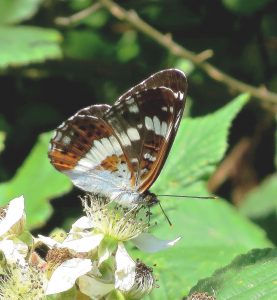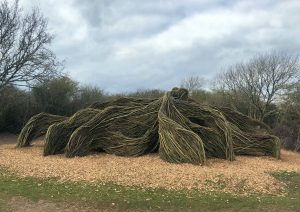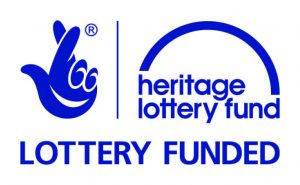Golden Hill Country Park
Welcome to Golden Hill Country Park extending to 20 hectares of mixed habitat public open space. The park was created in 1970 following military use from 1863 to 1962.
Golden Hill Country Park surrounds one of the Palmerston Follies that were built to protect the Solent from invasion. Built on high ground it was designed to defend and support the coastal batteries. The Fort itself is now luxury flats and has pretty much disappeared from view. Gift to Nature manages the Country Park which was once part of the military estate, after World War I it was home to thousands of soldiers who were being demobbed.
Throughout the park you will find a series of lecterns and pillars where you can stop and look, or listen, for something special – maybe a white admiral butterfly or the remains of a military building nestling in the undergrowth.
There are three new trails to help explore – A Red Squirrel Walk, a View Point Walk and a longer Wildlife Walk that takes in the open grassland, the woodlands and ponds.
‘Golden Hill’ was not named after the colour of Common Gorse bushes that are found around the site, as many have claimed. Instead it is recorded in 1299 as ‘Gaul Down’ which means the ‘rented hill’.
We have rescued the Copper Beech planted by Earl Mountbatten, from being outcompeted by more invasive species and cleared the way to reveal the stunning views looking across toward Fort Victoria and Fort Albert.

What to look and listen for …
The views are brilliant – for these take the Viewpoint Walk as you will be able to look in all directions. But there so much to see in the park too. In spring, look out of glades of primroses, and slightly later cowslips. Orchids can be found throughout the park from spring to summer starting with good displays of early purple orchid in spring followed by southern marsh orchid, plus the occasional pyramidal and bee orchid. Between June and early August you might find a white admiral butterfly.
Within the woodland you can find at least three ponds that tend to be seasonal as they often dry up in the summer. Here you can see dragonflies and damselflies such as the broad-bodied chaser. Some years newts are present and it is likely frogs and toads are also using the ponds from time to time. The Squirrel Walk is the best place to see squirrels. Look out for the remains of First World War army buildings, they are all over the park.
Where the scrub is thick you can hear birds such as blackcap and white throat. These are generally shy birds so you normally have to be content to listen out for their singing or calls. Other frequently heard birds within the park are jay, green woodpecker, magpie, robin. Blue tit, long-tailed tit, blackbird, song thrush, goldcrest, chaffinch, buzzard and sparrow hawk are also seen and heard.You will hear lots of coo-ing from wood pigeons and collared doves as well as mewing from herring gulls above the Solent
… and smell and touch

In spring, smell the gorse, it’s like coconut and there is stinking iris, particularly in the pond area. Also in the woodland smell the honeysuckle – it’s food for the white admiral caterpillar.
Enjoy our maze, and the plinths alongside. Some of the world war one remains have etched plaques which detail their original floor design. There are engraved discs on the back of some of our posts and pillars, these reflect the wildlife around. Look out for the cairn that commemorates the opening of the park in 1970. Help yourself to seasonal berries but leave some for the birds. We also have a community orchard by the car park – please have some fruit if you are hungry,
Please look at our sub-pages to find out more about the nature and heritage you can find at this site.
The story of Golden Hill Country park
Also from the right side bar menu
Nature at home and activities on site
We have produced a super Colouring Sheet for you to download and complete at home. We have also produced an I Spy Sheet and Map for you to print at home, or download to your phone and take to the site. And become a Bug Bunch Ranger. All these activities and resources can be found here.
The Golden Hill Golden Celebrations Project
In 2019 we secured a grant from The Heritage Lottery Fund for an ambitious project to discover the heritage of the site. As part of that project the military history was extensively researched and recorded, with the foundations of many the original world war one buildings revealed, new wildlife trails and heritage pillars were created, access was improved and interpretation installed across the site to help users connect with the history and local flora and fauna.
The Fort going into private ownership seemed to remove the heart of the site, so to return a much needed focal point, we commissioned a willow sculptor to create a new organic installation, echoing the fort but created for discovery and play. Made from natural willow and hazel and other cut material, the new maze like structure with its supporting buttress like arms and viewing windows has brought the whole site to life again with all generations embracing this marvellous structure made from natural willow sourced form local Afton Marsh.
How to get there
On foot and by bike – Bridleway F15 runs north-south through the site, providing a connection with Freshwater Village (via Longhalves) to the south and Norton Green to the north. Bridleway F70 circles through the site and Footpath F14 also passes through from Norton to Heathfield Road. There are cycle racks in the car park.
By bus – School Green Road stop (Routes 7 and12) then take footpath F18, leading to F15. Monks Lane stop (Island Coaster and Needles Breezer) then follow footpath F15. (Bus Timetables)
By car – The site is signed from Hill Lane / Colwell Road, turn off to Golden Hill Park industrial estate then immediately right, following signs. Use postcode PO40 9SJ for satnav.
what3words for car park ///begins.space.summaries
Access
This is a site on a hill with a gradient of about 1 in 12.
There are three signed routes around the park – The Viewpoint Walk, The Squirrel Walk and The Wildlife Walk.
There is a Information Pillar at the entrance to the site on the bridleway behind the Information Shelter. The site information pillar has a QR code that links to an audible description detailed below. The information pillar also has a QR code that links to a map and activities. There is also a site map on the Information Pillar
There is a circular route around the site which is suitable for all users including those with wheelchairs and mobility scooters. All interpretation boards are placed at a suitable height to be read from a sitting position and all but one board can be read from the path of loose chippings. This is signed the “Viewpoint Walk”.
Other paths within the site are of varying quality and most are grass or bare earth. The main tracks are level and mostly well-drained. There are a number of benches throughout the site and a picnic area with several tables that can accommodate wheelchair users. There is a bridge near the pond that is made of two planks and is less than 50 cm wide. The pond area is tricky for people with mobility difficulties.
As well as interpretation boards, which explain the natural and built heritage of the site, there are a number of information pillars dotted around that highlight opportunities to stop and look or listen for something. This is a site that changes significantly with the seasons.
There are no nearby public toilets. The nearest toilets are in the village of Freshwater. You will also find plenty of refreshment opportunities there.
We have written an Access Statement for this site. This includes mobility and sensory issues and opportunities. We welcome feedback from users.

We have produced an audible description creating a mind’s eye view of the area to allow a visually impaired person to enter with confidence. It will describe the entrance, the size of the area, where to find further information or help and any major obstacles or features. Information has been produced by visually impaired people ensuring it is useful and accurate. Access the description by scanning the QR code to the left of this text on your phone or tablet, or by clicking here.
Get Involved
There are various ways you can help improve and maintain our sites. We rely on volunteers to help with many tasks on our sites and also need people who are happy to regular visit the site be our “eyes and ears”, this means we can respond much quicker to issues. Our shop raises money to support our work and needs a team of volunteers. Or maybe you would like to help us with events. Find out more here.
You can also help by becoming one of our regular supporters. Even giving a few pounds each month can make a real difference, with your donation being invested into site management and improvement work to benefit site visitors and look after our precious wildlife. Sign up here.


